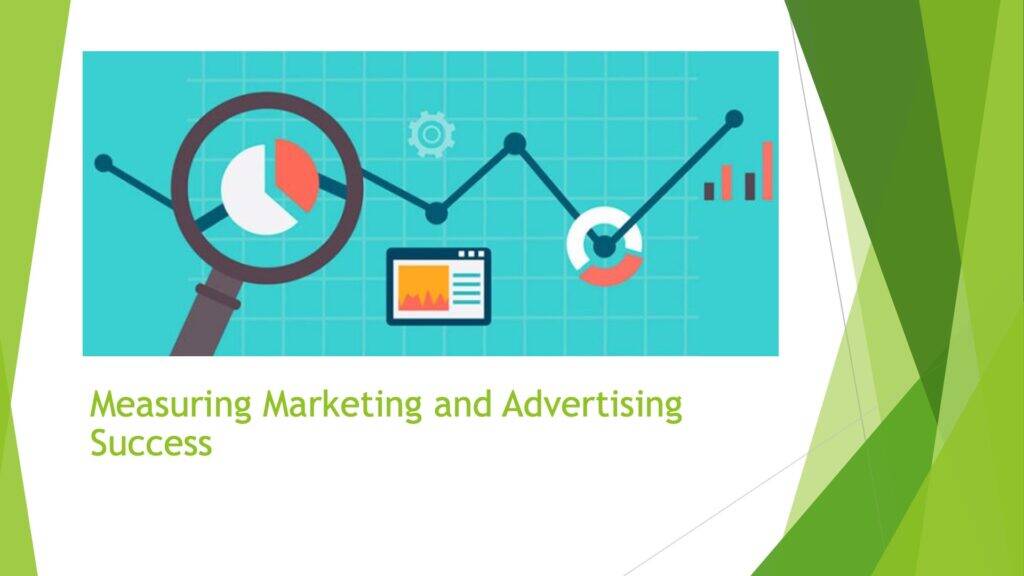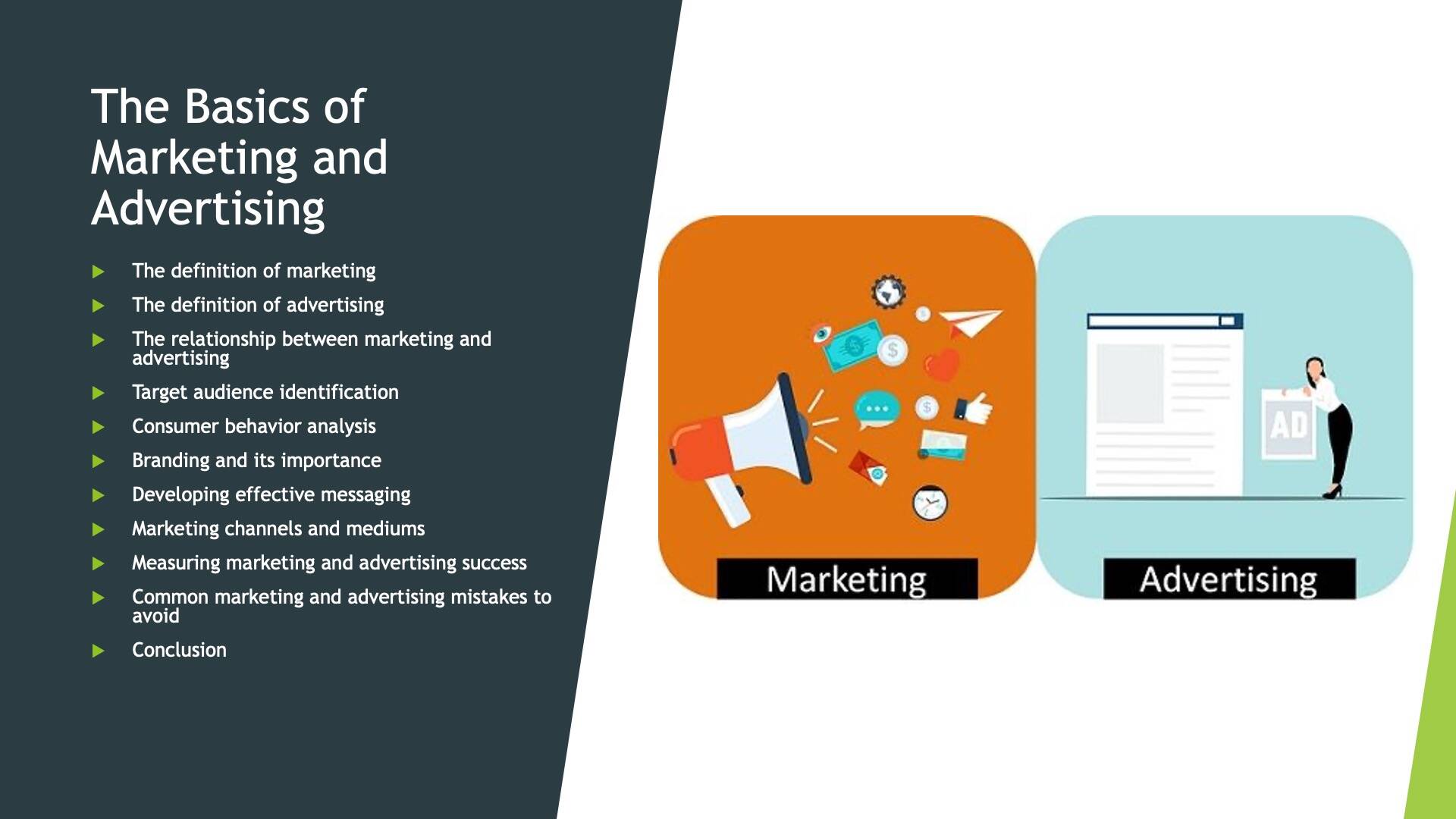Marketing and advertising are two essential components of any successful business strategy. While the terms are often used interchangeably, they are distinct concepts that serve different purposes in the overall marketing mix. In this article, we will explore the basics of marketing and advertising and explain the differences between them.
Introduction
Marketing is a broad concept that encompasses all the activities that a business undertakes to promote its products or services. The primary goal of marketing is to create awareness and interest among potential customers and ultimately convert them into loyal customers. Marketing activities can include market research, product development, pricing strategies, distribution and promotion.
Advertising, on the other hand is a subset of marketing that involves the paid promotion of products or services through various channels. The goal of advertising is to create awareness, generate interest and ultimately persuade potential customers to buy a product or service. Advertising can take many forms including print ads, TV and radio commercials, billboards, online banner ads and social media advertising.
Marketing and advertising work together to create a cohesive strategy for promoting a business and its products or services. Marketing lays the groundwork for advertising by defining the target market, developing messaging and branding and identifying the channels through which to reach potential customers. Advertising then takes that messaging and branding and uses it to create compelling campaigns that resonate with the target audience.
One of the most important elements of any marketing and advertising strategy is understanding the target audience. To be successful, businesses must identify the demographics, behaviors and preferences of their target market and tailor their messaging and advertising efforts accordingly. This requires a deep understanding of consumer behavior and the ability to analyze data and trends to identify the most effective marketing and advertising channels.
Another important aspect of marketing and advertising is branding. A strong brand identity is essential for creating a unique and recognizable image for a business and its products or services. This can involve developing a logo, tagline and visual elements that reflect the company’s values and mission. Effective branding can help businesses stand out in a crowded marketplace and build trust and loyalty among customers.
In addition to branding, businesses must also develop effective messaging that resonates with their target audience. This messaging should highlight the unique benefits of the product or service and address the pain points and challenges of potential customers. Effective messaging can help businesses build a strong emotional connection with their customers and create a sense of trust and loyalty.
In conclusion, marketing and advertising are essential components of any successful business strategy. While marketing encompasses all the activities involved in promoting a business and its products or services, advertising is a subset of marketing that involves the paid promotion of products or services through various channels. Understanding the target audience, developing a strong brand identity and creating effective messaging are all key elements of a successful marketing and advertising strategy. By mastering these basics, businesses can create compelling campaigns that resonate with their customers and ultimately drive sales and revenue.

The definition of marketing
Marketing is a broad and dynamic field that encompasses a range of activities aimed at promoting and selling products or services. While most people have a general understanding of what marketing entails, the definition of marketing can vary depending on the context and perspective. We will explore the definition of marketing and explain its fundamental concepts and principles.
At its core, marketing is the process of creating value for customers and building strong relationships with them. This involves understanding customer needs and preferences, developing products or services that meet those needs and promoting those products or services in a way that resonates with the target audience.
Marketing activities can take many forms, including market research, product development, pricing strategies, distribution and promotion. Each of these activities plays a critical role in creating value for customers and building brand awareness and loyalty.
Market research is a foundational aspect of marketing that involves gathering and analyzing data about the target market, including demographic information, behaviors and preferences. This information is then used to inform product development and marketing strategies.
Product development is the process of creating or refining products or services that meet the needs and preferences of the target market. This can involve identifying gaps in the market or improving existing products based on customer feedback.
Pricing strategies involve determining the optimal price for a product or service that maximizes revenue while still being competitive in the market. This can involve conducting market research to understand price sensitivity and consumer behavior.
Distribution involves getting products or services to the target market through various channels such as online marketplaces, retail stores or direct sales.
Promotion is the process of communicating the value of a product or service to the target audience through various marketing channels such as advertising, public relations and social media. Effective promotion involves creating compelling messaging that resonates with the target audience and differentiates the product or service from competitors.
In addition to these core activities, marketing also involves building and maintaining strong relationships with customers. This includes providing excellent customer service, addressing customer concerns and complaints and rewarding customer loyalty through incentives and special offers.
In conclusion, the definition of marketing is the process of creating value for customers and building strong relationships with them. This involves understanding customer needs and preferences, developing products or services that meet those needs and promoting those products or services in a way that resonates with the target audience. By mastering these fundamental concepts and principles, businesses can create compelling marketing strategies that drive revenue and build brand awareness and loyalty.

The definition of Advertising
Advertising is a critical aspect of marketing that involves creating and delivering persuasive messages to promote products, services or ideas. It is a powerful tool that businesses and organizations use to inform, educate and persuade their target audience. We will explore the definition of advertising and explain its fundamental concepts and principles.
Advertising can be defined as the process of creating and delivering persuasive messages to a target audience with the intention of promoting a product, service or idea. It is a form of communication that seeks to inform and persuade potential customers to take a specific action such as purchasing a product or service, attending an event or supporting a cause.
The primary goal of advertising is to create awareness and build brand recognition. It is an essential part of the marketing mix and is used to reach a specific target audience through various mediums such as television, radio, print and digital media. Effective advertising requires a deep understanding of the target audience and their needs and preferences.
Advertising can take many forms, including display ads, banner ads, video ads, social media ads and influencer marketing. Each of these forms has its own unique advantages and disadvantages and businesses must choose the right medium based on their target audience, budget and marketing goals.
Display ads are a type of online advertising that appears on websites in the form of banners or boxes. They are effective in generating brand awareness and driving traffic to a website.
Banner ads are similar to display ads but are typically smaller in size and appear at the top or bottom of a web page. They are commonly used for retargeting campaigns and are effective in reminding potential customers about a product or service they have already shown an interest in.
Video ads are becoming increasingly popular and are an effective way to engage and inform potential customers. They can be displayed on social media platforms, websites or video-sharing platforms such as YouTube.
Social media advertising involves using social media platforms such as Facebook, Twitter or Instagram to promote products or services. This form of advertising is effective in reaching a specific target audience and engaging with them directly.
Influencer marketing is a form of advertising that involves partnering with social media influencers to promote products or services. This is an effective way to reach a highly engaged audience and build brand recognition.
Advertising is a critical aspect of marketing that involves creating and delivering persuasive messages to a target audience with the intention of promoting a product, service or idea. It is an essential tool that businesses and organizations use to inform, educate and persuade potential customers to take a specific action. Effective advertising requires a deep understanding of the target audience and their needs and preferences and the use of the right medium to reach them. By mastering these fundamental concepts and principles, businesses can create compelling advertising campaigns that drive revenue and build brand recognition.

The Relationship Between Marketing And Advertising
Marketing and advertising are two closely related concepts that are often used interchangeably. While they share some similarities, they also have important differences. We will explore the relationship between marketing and advertising and how they work together to achieve business goals.
Marketing is the process of creating, communicating, delivering and exchanging offerings that have value for customers, clients, partners and society at large. It is a broad term that encompasses a range of activities, including market research, product development, pricing, distribution and promotion.
Advertising, on the other hand is a subset of marketing that focuses specifically on creating and delivering persuasive messages to a target audience through various media channels, such as television, radio, print and digital media. The primary goal of advertising is to create awareness and generate interest in a product or service, with the ultimate aim of driving sales.
While marketing and advertising are distinct concepts, they are closely related and work together to achieve business objectives. Here are some ways in which they are related:
Advertising is a key component of marketing: Advertising is one of the most visible aspects of marketing and it plays an important role in creating awareness and generating interest in a product or service. Without advertising, it would be much more difficult to reach potential customers and communicate the value of a product or service.
Marketing provides the strategic framework for advertising: Before advertising can be effective, there needs to be a clear understanding of the target audience, the product or service being offered and the business goals. Marketing provides the strategic framework for advertising by defining these key elements.
Advertising helps to build brand awareness: Brand awareness is an important component of marketing and advertising is one of the most effective ways to build it. By creating memorable and impactful advertising campaigns, businesses can create a strong brand identity that resonates with customers.
Marketing provides a feedback loop for advertising: Marketing activities such as market research and customer feedback can provide valuable insights into how advertising campaigns are resonating with the target audience. This feedback loop can help businesses to refine their advertising strategies and improve their overall marketing effectiveness.
Marketing and advertising are closely related concepts that work together to achieve business objectives. While they are distinct concepts, they share a common goal of creating value for customers and generating revenue for businesses. By understanding the relationship between marketing and advertising, businesses can develop more effective marketing strategies that drive growth and achieve their goals.

Target audience identification
Target audience identification is a critical aspect of any marketing strategy. It involves understanding the characteristics and preferences of the group of people that are most likely to be interested in a product or service. By identifying a target audience, businesses can tailor their marketing efforts to more effectively reach and engage potential customers. We will explore the importance of target audience identification and provide some tips for how businesses can identify their ideal target audience.
Why is Target Audience Identification Important?
Identifying a target audience is important for several reasons:
Improved marketing effectiveness
By focusing marketing efforts on a specific target audience, businesses can tailor their messaging and marketing channels to more effectively reach and engage potential customers.
Cost-effective advertising
Targeted advertising is often more cost-effective than broad-based advertising because it is more likely to reach people who are interested in a product or service.
Increased customer loyalty
When businesses understand their target audience and create products and services that meet their needs and preferences, they are more likely to build strong customer loyalty.
Tips for Identifying Your Target Audience
Conduct Market Research
Conducting market research is a key step in identifying a target audience. This can involve gathering information about the demographics, psychographics and behavior patterns of potential customers.
Analyze Your Existing Customer Base
Analyzing the characteristics of existing customers can provide valuable insights into the target audience. This can include factors such as age, gender, income level, education level and geographic location.
Identify Customer Needs
Understanding the needs, preferences and pain points of potential customers can help businesses to identify their ideal target audience. This can involve gathering feedback through surveys, focus groups and customer reviews.
Evaluate Your Competition
Analyzing the marketing strategies of competitors can help businesses to identify gaps in the market and target a specific audience that is not being adequately served.
Create Customer Personas
Creating customer personas can help businesses to develop a deeper understanding of their target audience. These personas should be based on real-world data and should include details such as age, gender, occupation, interests and behavior patterns.
Identifying a target audience is a critical aspect of any marketing strategy. By understanding the characteristics and preferences of potential customers, businesses can tailor their marketing efforts to more effectively reach and engage their target audience. By conducting market research, analyzing the existing customer base, identifying customer needs, evaluating the competition and creating customer personas, businesses can identify their ideal target audience and develop marketing strategies that drive growth and achieve business goals.

Consumer Behavior Analysis
Consumer behavior analysis is the study of the psychological and behavioral processes that consumers go through when making purchasing decisions. Understanding consumer behavior is critical for businesses as it helps them to create products and services that meet the needs and preferences of their target audience. We will explore the importance of consumer behavior analysis and provide some tips for how businesses can conduct a thorough analysis.
Importance of Consumer Behavior Analysis
Understand Customer Needs
By analyzing consumer behavior, businesses can gain insights into the needs and preferences of their target audience. This helps them to create products and services that are tailored to meet these needs and preferences.
Develop Effective Marketing Strategies
By understanding consumer behavior, businesses can develop marketing strategies that effectively reach and engage potential customers. This can involve creating targeted messaging, identifying the most effective marketing channels and developing pricing strategies that resonate with the target audience.
Identify Opportunities for Growth
Consumer behavior analysis can help businesses to identify opportunities for growth and innovation. By identifying gaps in the market, businesses can develop new products and services that meet unmet customer needs.
Tips for Conducting Consumer Behavior Analysis
Conduct Market Research: Conducting market research is a critical first step in analyzing consumer behavior. This can involve gathering information about the demographics, psychographics and behavior patterns of potential customers.
Analyze Customer Data
Analyzing customer data can provide valuable insights into consumer behavior. This can involve analyzing purchase history, customer feedback and other customer data to identify patterns and trends.
Use Surveys and Focus Groups
Surveys and focus groups are effective tools for gathering feedback directly from consumers. These tools can provide valuable insights into consumer attitudes, preferences and behavior patterns.
Monitor Social Media
Monitoring social media can provide valuable insights into consumer behavior. This can involve analyzing social media conversations and monitoring sentiment to identify trends and patterns.
Use Analytics Tools
Analytics tools such as Google Analytics can provide valuable insights into consumer behavior on a business’s website. This can involve analyzing website traffic, user behavior and other metrics to identify trends and patterns.
In conclusion, consumer behavior analysis is critical for businesses that want to create products and services that meet the needs and preferences of their target audience. By conducting market research, analyzing customer data, using surveys and focus groups, monitoring social media and using analytics tools, businesses can gain valuable insights into consumer behavior and develop marketing strategies that effectively reach and engage their target audience.

Branding and its Importance
Branding is the process of creating a unique name, design, symbol, or other feature that identifies and differentiates a company or product from others in the market. In today’s competitive business landscape, branding has become an essential component of any successful marketing strategy. We will explore the importance of branding and its benefits for businesses.
Importance of Branding
Builds Trust: Branding helps businesses to build trust with their target audience. When a company has a strong brand it communicates a message of quality, reliability and professionalism. This helps to build a positive image and reputation for the company in the minds of its customers.
Differentiates from Competitors: In a crowded marketplace, branding helps businesses to differentiate themselves from their competitors. A unique and recognizable brand can help to make a business stand out and capture the attention of potential customers.
Creates Brand Loyalty: Strong branding can create a sense of loyalty among customers. When customers feel connected to a brand they are more likely to become repeat customers and recommend the brand to others.
Increases Brand Awareness: Branding helps businesses to increase their visibility and awareness in the marketplace. A strong brand can make it easier for businesses to attract new customers and retain existing ones.
Increases Perceived Value: When a business has a strong brand it can increase the perceived value of its products or services. This can enable the business to charge a premium price for its offerings.
Benefits of Branding
Competitive Advantage: Strong branding gives businesses a competitive advantage in the marketplace. By differentiating themselves from their competitors, businesses can attract more customers and increase their market share.
Increased Sales: Effective branding can lead to increased sales and revenue for a business. When customers are familiar with a brand, they are more likely to purchase its products or services.
Improved Employee Morale: Branding can also have a positive impact on employee morale. When employees are proud to work for a company with a strong brand, they are more likely to be engaged and motivated in their work.
Stronger Relationships with Customers: Effective branding can help businesses to build stronger relationships with their customers. When customers feel connected to a brand, they are more likely to trust the business and become loyal customers.
Long-Term Value: Strong branding can provide long-term value for a business. By investing in branding, businesses can create a lasting legacy that will continue to benefit them for years to come.
In conclusion, branding is an essential component of any successful marketing strategy. By building trust with customers, differentiating from competitors, creating brand loyalty, increasing brand awareness, and increasing perceived value, businesses can enjoy a range of benefits including increased sales, improved employee morale, stronger relationships with customers and long-term value.

Developing Effective Messaging
Developing effective messaging is critical to the success of any marketing or advertising campaign. The messaging is the language and tone used to communicate the benefits of a product or service to the target audience. We will explore the key steps to developing effective messaging and how it can benefit businesses.
Identify Your Target Audience
The first step to developing effective messaging is to identify your target audience. This includes understanding their demographics, psychographics and behaviors. By understanding your audience you can tailor your messaging to resonate with them and address their pain points and needs.
Define Your Unique Selling Proposition
Your unique selling proposition (USP) is what sets your product or service apart from your competitors. It is the reason why your target audience should choose your product or service over others in the market. Your messaging should focus on communicating this USP in a clear and concise manner.
Craft a Compelling Headline
A compelling headline is essential to capturing the attention of your target audience. Your headline should be short, attention-grabbing and communicate the primary benefit of your product or service. It should make your target audience want to read more and learn about what you have to offer.
Focus on Benefits, Not Features
When developing messaging it’s important to focus on the benefits of your product or service, not just the features. Benefits are what your target audience will gain from using your product or service. By highlighting these benefits you can demonstrate the value of your offering and how it can improve their lives.
Use Persuasive Language
Persuasive language is the key to convincing your target audience to take action. Use language that creates a sense of urgency, highlights the benefits of your product or service and addresses any objections or concerns your target audience may have.
Keep it Simple and Consistent
Effective messaging should be simple and consistent across all marketing channels. Use straightforward language and avoid technical jargon or complex language that may confuse your target audience. Consistency in messaging helps to build trust and credibility with your target audience.
Developing effective messaging is critical to the success of any marketing or advertising campaign. By identifying your target audience, defining your unique selling proposition, crafting a compelling headline, focusing on benefits, using persuasive language and keeping it simple and consistent, businesses can create messaging that resonates with their target audience, drives conversions and builds brand loyalty. Remember that messaging is an ongoing process and should be continually refined and updated based on feedback and results.

Marketing Channels and Mediums
Marketing channels and mediums refer to the various ways businesses can promote their products or services to their target audience. The choice of marketing channel and medium will depend on several factors including the nature of the product or service, target audience demographics and psychographics, budget and business goals. We will explore the various marketing channels and mediums available to businesses.
Digital Marketing Channels and Mediums
Digital marketing channels and mediums have become increasingly popular due to their ability to reach a wide audience at a relatively low cost. Some examples of digital marketing channels and mediums include social media marketing, search engine optimization, email marketing, content marketing and pay-per-click advertising.
Traditional Marketing Channels and Mediums
Traditional marketing channels and mediums are still relevant today, particularly for businesses targeting a local audience. Some examples of traditional marketing channels and mediums include print advertising, direct mail marketing, television advertising, radio advertising and outdoor advertising.
Public Relations
Public relations refers to the efforts businesses make to create a positive image and relationship with the public. Some examples of public relations channels and mediums include press releases, media interviews, sponsorships and events.
Referral Marketing
Referral marketing involves encouraging existing customers to refer their friends and family to your business. This can be done through word-of-mouth, referral programs or influencer marketing.
Partnership Marketing
Partnership marketing involves forming strategic partnerships with other businesses or organizations to promote your products or services. This can include co-branding, cross-promotions and affiliate marketing.
When selecting a marketing channel and medium, businesses should consider their target audience, budget and goals. It’s important to conduct research to determine which channels and mediums are most effective for reaching your target audience and achieving your goals. Testing and measuring the effectiveness of different channels and mediums can also help businesses determine the best approach.
Marketing channels and mediums are critical to the success of any marketing campaign. By selecting the right channel and medium for your business you can reach your target audience effectively and efficiently, build brand awareness and drive conversions. Whether you choose digital, traditional, public relations, referral or partnership marketing it’s important to be consistent and authentic in your messaging and branding across all channels and mediums.

Measuring Marketing and Advertising Success
Marketing and advertising are critical components of any successful business strategy. However simply creating and distributing marketing and advertising content is not enough to guarantee success. It’s essential to measure the effectiveness of your marketing and advertising campaigns to determine what’s working and what’s not. We will explore the key metrics and tools used to measure marketing and advertising success.
Key Performance Indicators (KPIs)
KPIs are metrics that are used to measure the success of a marketing or advertising campaign. Common KPIs include website traffic, engagement rates, conversion rates, customer lifetime value and return on investment (ROI). KPIs will vary depending on the goals of your campaign and it’s essential to select KPIs that align with your business objectives.
Web Analytics
Web analytics tools are used to measure website traffic, engagement and conversion rates. Google Analytics is a popular web analytics tool that provides businesses with data on website traffic, user behavior and conversion rates. Other web analytics tools include Adobe Analytics, Mixpanel and Kissmetrics.
Social Media Analytics
Social media analytics tools are used to measure the effectiveness of social media campaigns. These tools provide data on engagement rates, follower growth, reach and impressions. Popular social media analytics tools include Hootsuite, Buffer, Sprout Social and HubSpot.
Surveys and Feedback
Surveys and customer feedback can provide valuable insights into the effectiveness of your marketing and advertising campaigns. Survey tools such as SurveyMonkey and Qualtrics can be used to gather feedback from customers and measure customer satisfaction levels.
A/B Testing
A/B testing is a method used to measure the effectiveness of different marketing and advertising campaigns. By creating two versions of a campaign and measuring the performance of each businesses can determine which version is more effective. A/B testing can be done with email marketing campaigns, landing pages and social media ads.
Measuring the success of your marketing and advertising campaigns is critical to achieving your business goals. By selecting the right KPIs, utilizing web and social media analytics tools, gathering customer feedback and conducting A/B testing, businesses can gain insights into the effectiveness of their campaigns and make data-driven decisions to improve their marketing and advertising strategies. It’s essential to regularly measure and analyze your marketing and advertising data to make informed decisions and optimize your campaigns for success.

Common Marketing and Advertising Mistakes to Avoid
Marketing and advertising are essential components of any business strategy but there are common mistakes that many businesses make. These mistakes can result in wasted time, money, and effort and can negatively impact a business’s reputation.
Not Defining a Target Audience
One of the biggest mistakes businesses make is failing to define their target audience. A target audience is a specific group of people who are most likely to be interested in your product or service. Without identifying your target audience your marketing and advertising efforts will be ineffective. To avoid this mistake, conduct market research to determine who your target audience is their demographics, interests and pain points.
Ignoring Brand Consistency
Brand consistency is crucial to building a strong brand identity. If your marketing and advertising campaigns are inconsistent, it can confuse your audience and make it challenging to establish brand recognition. To avoid this mistake, ensure that all of your marketing and advertising materials including social media profiles, website design and email marketing campaigns reflect your brand identity.
Failing to Test and Analyze
Testing and analyzing your marketing and advertising campaigns is critical to improving their effectiveness. Many businesses fail to test their campaigns, leading to missed opportunities for improvement. To avoid this mistake, conduct A/B testing, analyze web and social media analytics data and gather customer feedback to optimize your campaigns for success.
Overlooking the Importance of SEO
Search engine optimization (SEO) is critical to ensuring that your website and marketing materials are visible to potential customers. Many businesses overlook the importance of SEO, resulting in poor search engine rankings and lost opportunities. To avoid this mistake, focus on optimizing your website and marketing materials for search engines by using keywords, meta descriptions and header tags.
Ignoring the Power of Social Media
Social media is a powerful marketing and advertising tool but many businesses fail to leverage its potential. To avoid this mistake, invest time and resources in creating a strong social media presence including regular posts, engagement with followers and social media advertising.
Marketing and advertising are essential components of any successful business strategy but common mistakes can hinder their effectiveness. To avoid these mistakes, define your target audience, maintain brand consistency, test and analyze your campaigns, optimize for SEO and leverage the power of social media. By avoiding these common mistakes, businesses can optimize their marketing and advertising strategies for success.

Conclusion
Marketing and advertising are essential components of any successful business strategy. Marketing involves identifying customer needs and creating products or services that meet those needs while advertising involves promoting those products or services to potential customers.
To be successful in marketing and advertising, businesses must identify their target audience, maintain brand consistency, develop effective messaging and leverage the appropriate marketing channels and mediums. They must also measure their success through analytics and testing and avoid common mistakes such as failing to define a target audience, ignoring brand consistency, overlooking the importance of SEO and ignoring the power of social media.
Ultimately, marketing and advertising require a combination of creativity, strategy, and analysis. By following the basics and continuously refining their approach, businesses can build strong relationships with their customers and grow their bottom line.
